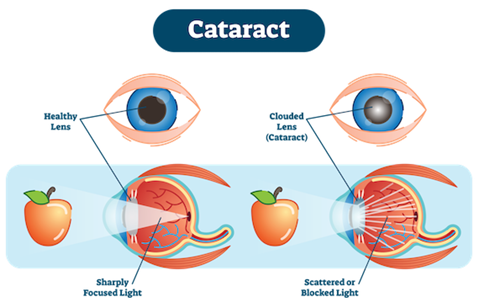What is a lens implant (intraocular lens implant, IOL) and do I need one with cataract surgery? The short answer is the lens implant is the part of cataract surgery that will allow you to see after cataract surgery and yes you need one.
Modern cataract surgery is the removal of the cloudy parts of the natural human lens of the eye and replacement with an artificial lens to allow the eye to focus. As our eyes age the natural lens of the eye begins to lose its natural flexibility around age forty and we begin to use reading glasses in our forties and fifties. Those who are naturally “nearsighted” (myopic) also may find that they can see better at near by removing their glasses. Many people will find the best range of vision using bifocals or progressive lenses. However, as the aging process continues, that natural lens begins to cloud and form cataract. In the early stages, cataracts may bother the vision only in certain lighting conditions (night driving, low sun angle, back-lighting) and sometimes a change of eyeglass prescription will keep you functioning well. Once the vision is at a point where you are having difficulty with some daily activities you may want to consider cataract surgery.

Your surgeon will review the specifics of your eye. Certainly the aging process affects more than just the lens of the eye. There may be definable conditions such as macular degeneration or corneal deformation that also affect your vision. There may be undefinable conditions where age just makes our retina less sensitive than when we were younger or even optical aberrations in our cornea that make it focus less precisely. Your surgeon will review these factors with you and be able to recommend specific lens implants to restore your vision to the greatest extent possible. This may be an extended range implant such as VIVITY (Alcon), a trifocal implant such as PANOPTIX (Alcon), an extended depth of focus implant such as SYMFONY (J&J), a toric monofocal implant or a standard monofocal implant.
Your cataract will most likely be removed with ultrasound (phacoemulsification) often times aided with the use of a femtosecond laser (Alcon LenSx). Less commonly the cataract will be removed with completely manual techniques. Once the cataract is removed a lens implant can be placed within the capsule the cataract was removed from. In rare cases a lens implant cannot be placed due to weak structures to support the lens and other means of optical correction will be needed.
Which lens implant will I get? More and more patients desire to be less eyeglass dependent. As well, lens implant technology has blossomed and the past couple of years have brought improved options to a much larger range of patients. VIVITY has allowed us to bring excellent distance and intermediate/computer vision to a wide range of patients. We are able to specifically address astigmatism. This lens seems to work very well even with mild co-existing eye conditions. The near vision with this lens is moderate and you should expect to need reading glasses for certain tasks. Night vision is excellent with this lens. PANOPTIX is a true multifocal trifocal lens. It offers excellent distance and intermediate vision and has stronger near vision than Vivity. Again we can specifically address astigmatism with this lens. Due to the design of the lens there can be some loss of contrast across all ranges of vision and many patients do report halos around lights at night. TORIC MONOFOCAL lenses are a good option for correction of astigmatism for good distance vision but these do not offer the increased range of vision that many patients desire. STANDARD MONOFOCAL lenses are a cost effective option for patients with little or no astigmatism who will be satisfied with a fixed range of vision.
You will have input into the surgical plan along with your surgeon. While there is no lens that is perfect and each person’s eyes are unique we are fortunate to have fantastic technology available to us. There will be out-of-pocket costs for any option other than a standard monofocal lens and your surgeon or coordinator will review those costs with you.
We strive to continue to improve the vision correction aspects to cataract surgery. Many patients are able to operate largely independent of glasses but it is always best to accept that you may still need some optical correction for certain tasks. Reasonable patient expectations are an important part of surgical success.
